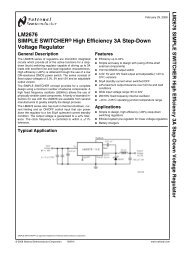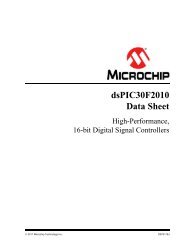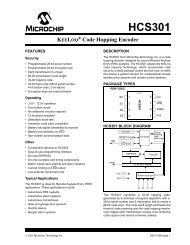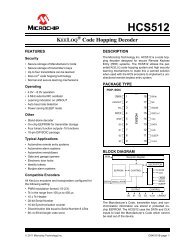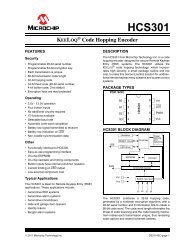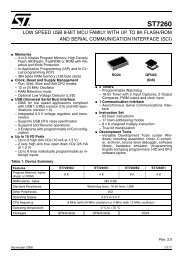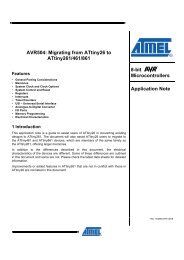Create successful ePaper yourself
Turn your PDF publications into a flip-book with our unique Google optimized e-Paper software.
<strong>STM32W108C8</strong><br />
Radio frequency module<br />
5.2.1 Tx baseband<br />
The <strong>STM32W108C8</strong> Tx baseband in the digital domain spreads the 4-bit symbol into its<br />
IEEE 802.15.4-2003-defined 32-chip sequence. It also provides the interface for software to<br />
calibrate the Tx module to reduce silicon process, temperature, and voltage variations.<br />
5.2.2 TX_ACTIVE and nTX_ACTIVE signals<br />
For applications requiring an external PA, two signals are provided called TX_ACTIVE and<br />
nTX_ACTIVE. These signals are the inverse of each other. They can be used for external PA<br />
power management and RF switching logic. In transmit mode the Tx baseband drives<br />
TX_ACTIVE high, as described in Table 25: GPIO signal assignments on page 62. In<br />
receive mode the TX_ACTIVE signal is low. TX_ACTIVE is the alternate function of PC5,<br />
and nTX_ACTIVE is the alternate function of PC6. See Section 8: General-purpose<br />
input/outputs on page 55 for details of the alternate GPIO functions.<br />
5.3 Calibration<br />
The ST RF software driver calibrates the radio using dedicated hardware resources.<br />
5.4 Integrated MAC module<br />
The <strong>STM32W108C8</strong> integrates most of the IEEE 802.15.4 MAC requirements in hardware.<br />
This allows the ARM® Cortex-M3 CPU to provide greater bandwidth to application and<br />
network operations. In addition, the hardware acts as a first-line filter for unwanted packets.<br />
The <strong>STM32W108C8</strong> MAC uses a DMA interface to RAM to further reduce the overall ARM®<br />
Cortex-M3 CPU interaction when transmitting or receiving packets.<br />
When a packet is ready for transmission, the software configures the Tx MAC DMA by<br />
indicating the packet buffer RAM location. The MAC waits for the backoff period, then<br />
switches the baseband to Tx mode and performs channel assessment. When the channel is<br />
clear the MAC reads data from the RAM buffer, calculates the CRC, and provides 4-bit<br />
symbols to the baseband. When the final byte has been read and sent to the baseband, the<br />
CRC remainder is read and transmitted.<br />
The MAC is in Rx mode most of the time. In Rx mode various format and address filters<br />
keep unwanted packets from using excessive RAM buffers, and prevent the CPU from being<br />
unnecessarily interrupted. When the reception of a packet begins, the MAC reads 4-bit<br />
symbols from the baseband and calculates the CRC. It then assembles the received data for<br />
storage in a RAM buffer. Rx MAC DMA provides direct access to RAM. Once the packet has<br />
been received additional data, which provides statistical information on the packet to the<br />
software stack, is appended to the end of the packet in the RAM buffer space.<br />
Doc ID 018587 Rev 2 30/215





